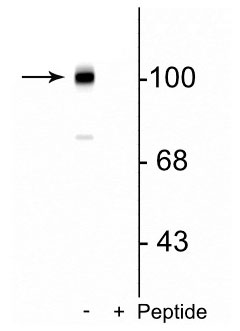Anti-Metabotropic Glutamate Receptor 7 (Ser862) Antibody
Our Anti-Metabotropic Glutamate Receptor 7 (Ser862) rabbit polyclonal phosphospecific primary antibo
- SPECIFICATION
- CITATIONS
- PROTOCOLS
- BACKGROUND

| Primary Accession | P35400 |
|---|---|
| Host | Rabbit |
| Clonality | Polyclonal |
| Isotype | IgG |
| Calculated MW | 102232 Da |
| Gene ID | 81672 |
|---|---|
| Other Names | FLJ40498 antibody, GLUR7 antibody, Glutamate receptor metabotropic 7 antibody, GPRC1G antibody, GRM7 antibody, GRM7_HUMAN antibody, Metabotropic glutamate receptor 7 antibody, MGLU7 antibody, mGluR7 antibody, OTTHUMP00000206961 antibody, OTTHUMP00000214674 antibody, OTTHUMP00000214675 antibody |
| Target/Specificity | Metabotropic glutamate receptors (mGluRs) are key receptors in the modulation of excitatory synaptic transmission in the central nervous system. They are implicated in many forms of neural plasticity as well as learning and memory and drug abuse (Bhattacharya et al., 2004; Francesconi et al., 2004; Wilson and Nicoll, 2001). The mGluRs are divided into three groups based on sequence identity and pharmacological properties: group I (mGluR1 and mGluR5) are localized in the perisynaptic region of the postsynaptic membrane, whereas group II (mGlur2 and mGluR3) and group III (mGluR4,6,7 and 8) are localized predominantly at presynaptic terminals. PKC phosphorylation of Ser-862 on mGluR7 has been shown to be critical for stabilizing receptor surface expression and promoting binding to the synaptic PDZ-domain-containing protein PICK1 (Suh et al., 2008). |
| Format | Antigen Affinity Purified from Pooled Serum |
| Storage | Maintain refrigerated at 2-8°C for up to 6 months. For long term storage store at -20°C in small aliquots to prevent freeze-thaw cycles. |
| Precautions | Anti-Metabotropic Glutamate Receptor 7 (Ser862) Antibody is for research use only and not for use in diagnostic or therapeutic procedures. |
| Shipping | Blue Ice |

Thousands of laboratories across the world have published research that depended on the performance of antibodies from Abcepta to advance their research. Check out links to articles that cite our products in major peer-reviewed journals, organized by research category.
info@abcepta.com, and receive a free "I Love Antibodies" mug.
Provided below are standard protocols that you may find useful for product applications.
Background
Metabotropic glutamate receptors (mGluRs) are key receptors in the modulation of excitatory synaptic transmission in the central nervous system. They are implicated in many forms of neural plasticity as well as learning and memory and drug abuse (Bhattacharya et al., 2004; Francesconi et al., 2004; Wilson and Nicoll, 2001). The mGluRs are divided into three groups based on sequence identity and pharmacological properties: group I (mGluR1 and mGluR5) are localized in the perisynaptic region of the postsynaptic membrane, whereas group II (mGlur2 and mGluR3) and group III (mGluR4,6,7 and 8) are localized predominantly at presynaptic terminals. PKC phosphorylation of Ser-862 on mGluR7 has been shown to be critical for stabilizing receptor surface expression and promoting binding to the synaptic PDZ-domain-containing protein PICK1 (Suh et al., 2008).
If you have used an Abcepta product and would like to share how it has performed, please click on the "Submit Review" button and provide the requested information. Our staff will examine and post your review and contact you if needed.
If you have any additional inquiries please email technical services at tech@abcepta.com.













 Foundational characteristics of cancer include proliferation, angiogenesis, migration, evasion of apoptosis, and cellular immortality. Find key markers for these cellular processes and antibodies to detect them.
Foundational characteristics of cancer include proliferation, angiogenesis, migration, evasion of apoptosis, and cellular immortality. Find key markers for these cellular processes and antibodies to detect them. The SUMOplot™ Analysis Program predicts and scores sumoylation sites in your protein. SUMOylation is a post-translational modification involved in various cellular processes, such as nuclear-cytosolic transport, transcriptional regulation, apoptosis, protein stability, response to stress, and progression through the cell cycle.
The SUMOplot™ Analysis Program predicts and scores sumoylation sites in your protein. SUMOylation is a post-translational modification involved in various cellular processes, such as nuclear-cytosolic transport, transcriptional regulation, apoptosis, protein stability, response to stress, and progression through the cell cycle. The Autophagy Receptor Motif Plotter predicts and scores autophagy receptor binding sites in your protein. Identifying proteins connected to this pathway is critical to understanding the role of autophagy in physiological as well as pathological processes such as development, differentiation, neurodegenerative diseases, stress, infection, and cancer.
The Autophagy Receptor Motif Plotter predicts and scores autophagy receptor binding sites in your protein. Identifying proteins connected to this pathway is critical to understanding the role of autophagy in physiological as well as pathological processes such as development, differentiation, neurodegenerative diseases, stress, infection, and cancer.


